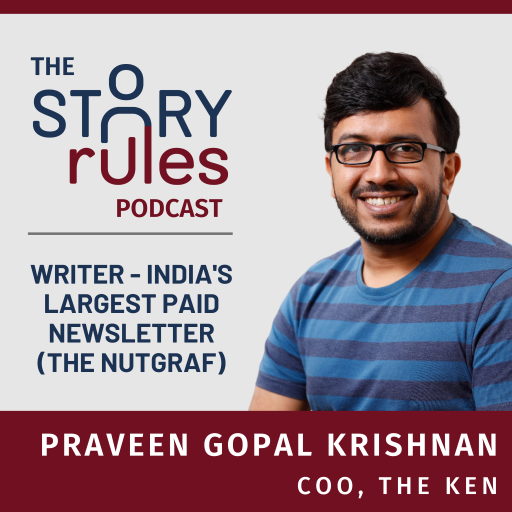E07: Praveen Gopal Krishnan: Writer of India’s largest paid newsletter
August 14, 2021 2023-01-18 17:58E07: Praveen Gopal Krishnan: Writer of India’s largest paid newsletter
The one email I look forward to reading every week
During the pandemic, my daily newspaper reading habit was replaced by India’s finest business-news subscription product: The Ken.
Very soon, The Ken became a habit. Every weekday morning at 7 am, I look forward to their daily newsletter, ‘Beyond the First Order’. Then at 8 am is the email introducing their long-form article of the day.
But there’s one write-up by The Ken that I look forward to the most – a weekly newsletter called The Nutgraf written by the maverick Praveen Gopal Krishnan (a.k.a. PGK), COO at the Ken.
If you’ve been a regular reader of the Nutgraf (or have even read occasional pieces), then fasten your seat belts. You’re in for a heck of a ride. I was blown away when I learnt how PGK actually does what he does.
If you haven’t read the Nutgraf, then here’s what I’d recommend.
– Check out the newsletter here
– Sign up for a free 30-day trial
– Read a couple of pieces (the 10,000 Engineer Rule is a great one to start)
– Be blown away
Then you can come back to this email.
(If you hadn’t known about The Ken – India’s premier subscription based business news publication – you’re welcome. I’d highly encourage you to subscribe – we should do all we can to support high-quality, non-ad-supported journalism).
Who has the most productive Friday evenings in journalism?
The Nutgraf is an indepth, 10-min analysis of a crucial topical issue – one that goes far deeper than the typical banalities and cursory analysis that masquerades as ‘opinion pieces’ in major dailies – and looks for ‘connections and consequences’ – in a way that makes the reader go “Ah, now I get it”.
Reading these fascinating, immensely thought-provoking pieces, I used to think: Man, they’ve employed a person just to write one article a week. This is how, I surmised, his schedule must be like for the week:
– Monday-Tuesday: Research
– Wed-Thursday: Writing, rewriting and edits
– Friday: Final proof-reads and hitting publish for Saturday.
Then I realised that it was written by someone who was the Head of Product at The Ken (now COO). Surely, he must be busy with, erm, Product-related responsibilities?
The new narrative in my head was – perhaps he spends most of his time on Product (say 75%) and then spends the balance 25% on writing.
Boy, how wrong I was.
PGK is a 100% Product guy. His job Monday to Friday is to work on The Ken’s product. And then, just as all of Bangalore finds its way into the pubs and restaurants in Indiranagar and Koramangala, our man starts. With his research.
In a manic, unprecedented, staggering five-hour marathon-sprint between 6 pm to 11 pm, PGK researches, understands, writes, edits and finalises the Nutgraf edition to be published the next day.
At around 10.30-11 pm he passes it on to his colleagues (God bless them) who review, edit and proof-read the content and add their comments.
The next morning, Praveen reviews the comments, resolves them and gets it ready for publishing. On some days, just in time at 10 am.
As I was saying, I was blown away.
In fact, when I heard about this writing process, I had one overwhelming thought: you remember the disclaimer you get at the beginning of an action reality TV series – something on the lines of “These stunts are done by professionals and must not be tried at home”?
Well, Praveen pulls off those kinds of stunts every week. He’s a bit of a maverick genius.
The Podcast conversation
In this podcast conversation, Praveen talks about:
– The early influence of reading (especially re-reading) on his life
– The impact of theatre
– His strong belief in the effectiveness of the three-act narrative structure in storytelling
– His love for Aaron Sorkin and
– Most fundamentally – why his newsletter is called the Nutgraf!
As always, I’m sharing some some extracts from the conversation – tagged under ‘the 3Ps’ – the Personal, Philosophical and the Practical.
(All emphasis mine):
1. Personal:
They say that ‘Creativity thrives in constraints’.
Praveen grew up in a small city in the Middle East called Al Ain. It was well-equipped otherwise (lots of KFCs), but it had a severe lack of the one thing a young reading-obsessed kid wanted the most: books.
So what did Praveen do? He re-read.
Here’s Praveen talking about his biennial trips to the Higginbothams book store in Bangalore where he was allowed to pick all of 15 books: “I would pick (the) 15 books … I would have read all 15 books in the first … like before I even left India … But for the rest of the two years, I had no option, I would just read (the same) books over and over again… So… when you are forced to read something over and over again, you start to see new things each time. Then you start to, I think, at some level, even though I could never really put this down, sort of implicitly start to understand… all of them have some commonalities with respect to characters, structure and narrative.”
Here’s my reaction to this fascinating point:
Ravi: “…for me, the very interesting difference, if I might say with others who read, is re-reading because we… a lot of us (say), ‘oh I’ve already read it, you know, why should I read it again?’
And I remember this, you know, I’m kind of digressing now. Boman Irani, right? So he started acting when he was 44. What a guy. And once he got an award at Filmfare or something, and then he was, you know, just narrating the story that when he was young, his mom used to kind of pay him money to watch a movie and you go watch a movie and come back and then she will say, Achha Did you see it? What did you think about the cinematography? And he’d say no, I just saw the characters. Okay, here, take money, go and watch that movie again, this time only see the cinematography. And then he’ll come back. So what do you think of the background music? Um, I don’t think I paid attention, Okay, take this money. Go back. See the movie again, just to hear the background music. Fascinating, right? Because a piece of art is ya…, a thing of beauty is a joy forever, right? So yeah… that I think, is a great insight for everybody.”
Incidentally, I managed to locate that Boman Irani clip (start from 4:10) – its a short and beautiful tribute to his mom, and a great storytelling lesson!
Interestingly when I had recorded this conversation, I was then ‘re-reading’ Sapiens, and was finding many connections that I didn’t find in the first read!
2. The Philosophical:
Praveen’s magic skill is to form the narrative in his head, while he is researching (with “about 80 tabs open on Chrome”!). That narrative is based on a simple storytelling structure.
Here’s Praveen: “So the way how I think about stories, and this is a combination of my childhood and theatre is… through a three act structure. There’s nothing else. Okay? And that is a construct that for a lot of people, they probably know, but it’s also a little elusive. So… the three act structure is the most, it’s probably the most ancient and the most common form of storytelling, which is that any story is broken into three acts, which means that there is a first act which is about a setup, there is a second act, which is about an escalation and there is a third act, which is about a resolution.
…Which means that it’s always inherent for me, whenever I start a story, when I’m doing a research, I generally know who the protagonist is, sometimes the protagonist is a company, sometimes the protagonist is a person, sometimes the protagonist is a vaccine… it could be anything. Once I know who the protagonist is, then all I’m looking for… (are) research points where the Act changes. And in general, always the place where one act moves to another is the point of change. And the more dramatic the change there, I know, I have got it. So if I’m talking about, say, a vaccine or something, and I’m just doing my research in, and I find something that is, oh, this is the point where something big, some big changes happened. I know that that’s it. This is where my first act ends, because… I just look at it and know. Okay, so I got it.”
Ravi: “So, while you’re reading, your brain has like a ‘three-act filter’, which is constantly looking for these breaking (or) critical points in the story?”
Praveen: “Absolutely. Absolutely. So that’s how I see it.”
Ravi: “Do you actually write this down while this is happening, somewhere. Or it’s in your head?”
Praveen: “It’s in my head, because it’s just like, I’m just doing it maniacally. So I’m just like, going tab after tab after tab of some… Yeah, I have a notes thing with me. So sometimes I just like catch something. And I’m like, Okay, this is here. Sometimes I do ‘This is here’. And sometimes I do ‘this is here’. And that’s it. So then I keep that with me…Then I’m like ‘Oh, I understand’. So now all I have to do is to figure out, how did it go from point A to point B? What are the events that happened from point A to point B? Because the points of change don’t change? Right? Yes, it doesn’t matter. It’s not about whether I’m telling it … regardless of the emotion. It’s not about a positivity, negativity doesn’t matter. This is a very fundamental point of change that has happened.”
The way Praveen applies this simple story framework to explain complex events is incredible and offers a powerful lesson.
3. The Practical
Now, this is the part of the post where I share some practical hacks used by the storyteller – which all of us can learn from.
In this case, these are hacks for sure, but they aren’t very practical. I don’t think the rest of us can learn much from them.
Because, remember “These stunts are performed by professionals and you should not try it at home”?
I asked Praveen about how he actually schedules the time on Friday late evenings.
Brace yourself, this will be a rough ride.
Praveen: “… I do snatches of research a little bit in the day, but I don’t actually because my Friday is very hectic. I think my research typically starts at 5:30-6. I’m mostly done with my research by 7-7:30.”
Ravi: “Oh amazing!”
Praveen: “Yeah. Because I’m just blazing through it. I’m just going tab after tab after tab. reading, reading, reading, reading, reading and just ‘got it, understood what it is’ by 7:30-8 and then I have some fable, some stories, something in my head. If there is something visual then perhaps in those 15-20% case it may happen later, but otherwise it doesn’t. By around 7:30-8, I find the image that I need on some stock image (site) and I send it to my design team and say, Can you just give me like this thing for that? And they’re like, okay.
I have to start writing by 7:30-8. I have gone beyond eight a couple of times. And that has been like a stretch. But 7:30-8 is the last… I have to start at eight. I start it and I get done by 10:30-10:45. I think maybe 5% of the cases that has gone to 11 -11:30. But almost never beyond”
Ravi: “Do you just write in one stretch?”
Praveen: “Yeah, no, no, no, no, I just go straight. I have this timer on my phone. It is this app called Tide, which every 45 mins…I follow the Pomodoro technique, which is you work very intensely for like some 40 minutes, and then you take a five minute break… Except what happens on Fridays is that five minute break never happens. So I’m just like, blasting through and then my alarm rings at 40 minutes – ‘Now you can take a five minute break’. No, no, I’m in the middle of this I can’t. So I just like keep blasting through. It’s a just a very high intense experience. There’s nothing like it…”
Surely there is nothing like it…
And there’s nothing like PGK murdering his Friday evenings so that you and I can get a better, deeper understanding of our world.
Finally, four things that stayed with me from the conversation:
1. Novelty can be over-rated in consuming content. Re-read and re-watch the good stuff you already have. You’ll come across insights that most others would have missed
2. Look for the key transition points in your story using the three-act structure
3. Use chronology (duh) to reconstruct the sequence of events
4. Deadlines can be stressful, challenging and irritating – but they work!
You can enjoy my conversation with Praveen at your favourite podcast location:
Browser
Podcast apps: Apple Podcasts | Spotify | Google Podcasts | Stitcher | Podcast Addict | Pocket Casts
Happy listening!
If you find this content valuable, please rate and review this podcast on iTunes, Spotify, Google Podcasts, or wherever you listen to them (links above). It’ll help others like you discover these insights!
This podcast episode was hosted by me, Ravishankar Iyer. Transcript editing by Sanket Aalegaonkar. Audio editing by Kartik Rajan.
Thanks
Ravi








